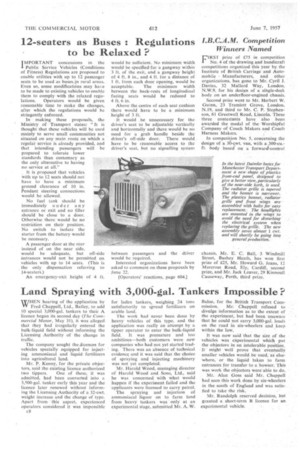Land Spraying with 3,006-gal. Tankers Impossible ?
Page 46

If you've noticed an error in this article please click here to report it so we can fix it.
WHEN hearing of the application by W Fred Chappell, Ltd., Batley, to add 10 special 3,000-gal. tankers to their A licence began its second day (The Commercial Motor, May 31), it was alleged that they had irregularly entered the bulk-liquid field without informing the Licensing Authority of the change in traffic.
The company sought the 'licences for vehicles specially equipped for injecting ammoniacal and liquid fertilizers into agricultural land.
Mr. P. Kenny, for the private objectors, said the existing licence authorized
two tippers. One of these, it was admitted, had been converted into a 3,500-gal. tanker early this year and the licence later renewed without informing the Licensing Authority of a 32-cwt. weight increase and the change of type. Apart fromthis aspect, experienced operators considered it was impossible
c8
for laden tankers, weighing 24 tons satisfactorily to spread fertilizers on arable land.
The work had never been done by heavy vehicles of this type, and the application was really an attempt by a tipper operator to enter the bulk-liquid field. It was premature and too ambitious—both customers were new companies who had not yet started trading. There was an absence of technical evidence and it was said that the choice of spraying and injecting machinery was not yet completed.
Mr. Harold Wood, managing director of Harold Wood and Sons, Ltd., said he was concerned with what would happen if the experiment failed and the 'applicants were licensed to carry petrol.
The spraying and injection of ammoniacal liquor on to farm land from heavy tankers was only at an experimental stage, submitted Mr. A. W. Balne, for the British Transport Com mission. Mr. Chappell refused to divulge information as to the extent of the experiment, but had been unaware that he could not carry 3,000-gal, loads on the road in six-wheelers and keep within the law, It was now said that the size of the vehicles was experimental which put the objectors in an intolerable position. It might well prove that eventually smaller vehicles would be used, as" elsewhere, or the liquid taken to farm entrances for transfer to a bowser. This was work the objectors were able to do.
Mr. Alan Goss said Mr. Chappell had seen this work done by six-wheelers in the south of England and was satisfied to take the risk.
Mr. Randolph reserved decision, but granted a short-term B licence for an experimental vehicle.












































































































